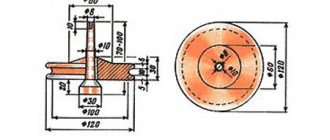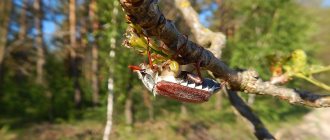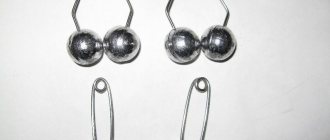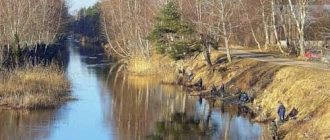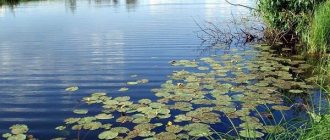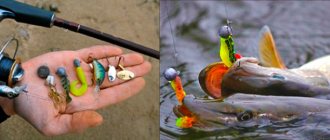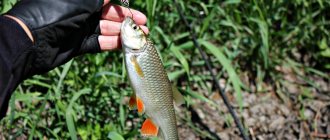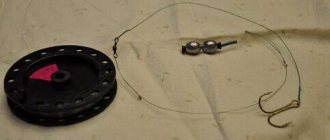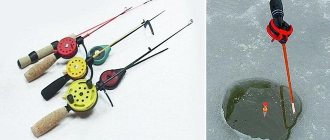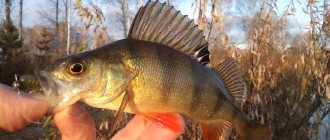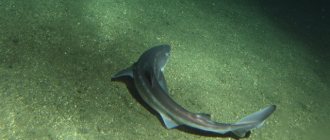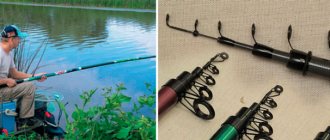General requirements for gear
Catching asp with a bombard combines some elements of fly and spinning fishing, so when choosing gear you need to take into account all the features.
Bombarda (Sbirulino)
It is thanks to the float that this type of fishing got its name. In a bombard rig, the float performs several functions. Firstly, it makes the tackle heavier and allows for long casts. Secondly, the float corrects the trajectory of the bait in the water. And thirdly, aerodynamic contours make it possible to overcome the resistance of air flows during casting.
Depending on the materials used, floats are divided into three types: sinking, slowly sinking and floating. Since the asp stays in the upper layers of the water, slowly sinking and floating models are used to catch it. Information about the float model is indicated on the product body using Latin letters.
Tip: Bombard floats are inexpensive, so take different types of floats with you when fishing. Even if they do not meet the expected fishing conditions.
In addition, there is also a classification of bombard floats according to the location of the sinker:
- “Classic” - this type of float has a small sinker located in the lower part of the body. This design allows you to quickly immerse the bait to the desired depth.
- “Moretto” - the load is evenly distributed along the entire length of the product. The float slowly sinks into the water.
- “Competishin” - the weight adjusts the center of gravity of the float. The float moves uniformly in the water column.
- “Magic” - sinkers are located along the edges of the body and provide maximum sensitivity.
To catch asp, bombards with a “magic” or “competishin” type design are most often used. If you have to fish with heavy baits, and the wiring is carried out in the upper layers of the water, then use floating bombards without sinkers.
Rod
Since the distance from the float to the bait sometimes reaches several meters, the rod needs to be long enough. Experienced fishermen claim that a rod 3.5-4.5 m long is quite enough. The equipment has a shifted center of gravity, so the rod must be soft enough to “shoot” the bait at the selected point. The action of the rod should be medium. If it is not possible to buy a special bombard rod, then you can take a feeder rod. The presence of more rings will allow you to evenly distribute the load along the entire length of the form. Some anglers use regular spinning rods, but in this case, every cast turns into a real test.
Coil
There are no specialized reels for fishing with sbirulino, but since the mechanism will experience constant loads, it should have increased wear resistance
In addition, you should pay attention to the gear ratio. For regular spinning reels it is 5:0, but for bombards you should use reels with a ratio of 5.1:0 and higher
This is due to the need for quick wiring.
fishing line
The fishing line used for fishing with sbirulino is quite thin. The small size of the rings on the rod does not allow the use of fishing line thicker than 0.2-0.22 mm. The fishing line must be strong enough and wear-resistant. Some anglers use thin braided cord instead of fishing line, but this can scare away wary fish. A fluorocarbon leash is used between the float and the bait.
Tip: To reduce the number of overlaps, you need to attach the leader to the main line using a triple swivel. In water, such a leash is not noticeable, since the material has an almost zero refractive index of light.
Lures
Bombard rig allows you to use all types of baits. Among the most frequently used it is worth remembering:
- dry and wet flies;
- small spoons;
- silicone baits;
- wobblers;
- bait of animal origin (fry, maggots, worms).
Some anglers use combination rigs. Small streamers located above the main bait allow you to simulate a chase.
Choosing a place to catch chub using a grasshopper
Choosing a suitable site on a river, lake or reservoir for catching chub with a grasshopper is usually not so difficult. Reservoirs are quite easy to read in summer. Based on the nature of the shore and the signs that are visible on the surface of the water, you can determine with a high degree of probability where the chub feeds.
Interesting fishing spots will be:
- rifts, as well as areas above and below them;
- boundaries of fast and slow, forward and reverse flow;
- areas under high steep banks on which grass grows.
If a chub feeds by collecting insects from the surface, this is quite clearly visible even from afar. Circles appear on the water, splashes are visible and heard, and sometimes the fish even jumps into the air. It is in such a place that you need to throw the grasshopper so that the chub will take it. You can take binoculars with you when fishing, which will help you quickly navigate the pond and look for interesting points.
Attention! It often happens that no traces of the presence of fish are noticeable on the surface of the water. There is an interesting technique that allows you to find a chub on the river in such conditions, which is ready to feed near the surface, including pecking at a grasshopper.
You need to take crusts of bread with you when fishing. When you approach an interesting point, you need to throw them into the water so that the current carries them down. If there is an active chub somewhere here, it will definitely show itself and start collecting bread. In this case, it will be possible to throw a rig with a grasshopper on the hook to the point where the fish appeared. If there are no chubs, you need to move on in search of the next promising place.
Catching chub with a grasshopper is, as a rule, not stationary fishing. It involves constantly moving along the river and checking one interesting point after another.
What is a front sight
A fly is one of the types of artificial baits, which is a fairly realistic imitation of the favorite insects of predatory and peaceful categories of fish. It shows its high efficiency at the end of spring and at the beginning of summer, when representatives of the ichthyofauna become hungry and they practically rush to any offered bait.
Artificial flies are especially in demand among predators who prefer live food. An insect that has fallen into the water begins to make every attempt to get out, eventually its wings become wet, heavy, and it dies. The bait imitating it should also behave in a similar way. The more believable the fly game is, the greater the chances of catching the coveted trophy.
Based on this, casting the bait should be accompanied by movement; if the water flow at the fishing point is weak, then you will need to tug the line a little. This simple technique allows you to activate potential prey and provoke it to capture an artificial insect.
In most cases, flies are made from natural material, including fur and feathers, but versions made from synthetic fibers are also quite successfully practiced. Here everything depends on the object of fishing. In the warm season, perch becomes a frequent prey, but in late autumn - pike perch. Starting from mid-summer, catching asp will be an effective hunt, but in order to attract it, it is necessary to equip the tackle with two or three baits. On hot days, it is better to rely on a dry type of fly.
Kinds
Considering the variety of artificial insects, they can be classified into the following groups:
Example of a wet fly
Wet flies. This species is similar to the larvae of tailless amphibians, leeches, beetles, drowned insects and their larvae. A characteristic feature of flies is a thin body, the presence of legs, a tail and wings directed towards the sting. They are tied on a thick hook and used in fly fishing. This bait option is more suitable for catching asp, grayling, and salmon.
Dry flies. This is a type of invertebrate that has fallen into the water, such as the gadfly, fly, caddisfly, honeydew, dragonfly, etc. The bait shows itself worthily on the surface of the water, it is capable of going deeper. To make dry flies, hard bird feathers are used, which ensures that the bait stays only on the surface. Hooks made of thin wire material are more suitable for these purposes. The popularity of the bait is due to its versatility.
Streamers. The devices represent juvenile fish, fry, common in a particular body of water. The originality of the bait lies in the presence of a long wing, longer than the size of the hook itself.
In addition, there is a body, a neck that looks like fins, scales in the form of a winding and bright, shiny components that significantly attract the attention of a predator, and a large one at that. The bait depicts a wounded victim, tied on a hook loaded with tungsten, steel
Such devices are heavy.
Nymphs. This variety is produced in both fantasy and natural versions. This is a plausible imitation of pupae, larvae - invertebrates at the stage of their development. In order for fishing to be as productive as possible, the color of the nymphs must match the nature of a particular body of water; the bait itself is tied on a hook, additionally equipped with lead wire. This artificial bait is in great demand among fly fishing enthusiasts.
Emergers. This is the most catchy fly for grayling, it is made in the form of an insect that is at the stage of transformation from a pupa to an adult. Even a passive predator cannot miss such bait.
Fantasy flies. This is a special type of device for attracting fish; they are distinguished by the lack of real prototypes. They are made exclusively based on the imagination of the fisherman himself, but taking into account the food preferences and behavior of the fish. Lures vary in color, size and shape. It is especially effective to make fancy flies when fishing for pike perch.
Grasshopper hooks
I consider hooks No. 5 and No. 7 optimal, although I also use other numbers. If desired, several grasshoppers can be hooked onto one hook at once, especially if they are small. It is better to leave the point of the hook free, so there will be more confidence that the fish will be hooked. You should not worry that the tip will scare away the fish, since the attack occurs very quickly and the fish does not “explore” the bait, but immediately grabs it.
By the way, if you wish, you can make a tackle from two hooks, which allows you to more securely secure the grasshopper and enjoy fishing. They catch grasshoppers both with fly fishing and with a regular float rod. In my practice, I only used a float rod. I recommend that you try catching a grasshopper. It's very exciting and unforgettable.
All the best to you.
Features and nuances of catfishing
Front sight and spinning rod
Ballerina sinker
The key point when selecting tackle using flies is the selection of the sinker. Considering that its main task during the hunt will be to move along the surface of the bottom, the optimal option for a weighting material is a spherical or pear-shaped shape. If fishing is planned in an area with a strong current, then choose a heavy sinker, and to catch prey in calm water, choose a light one. The shape and weight of the sinker directly depend on the specific fishing conditions.
For information! A “ballerina” sinker, made of wire material, with an eyelet at the end, is good because it reduces the likelihood of snagging.
Spinning equipment:
- Rod. The length of the fishing tool is 3-3.5 m, the action is medium. For fishing in overgrown areas of the reservoir, it will be important to use a light spinning rod 1.5 m long, and for fishing hard-to-reach places - a soft rod with a light weight.
- Coil. The model used must be from a trusted manufacturer and equipped with a smooth handle.
- Hooks. For fly fishing, it is more rational to use a double hook; it is more reliable, unlike a tee, from which the prey can easily get off (shake off). Another advantage of this choice is less snagging in dense vegetation.
- Main line. When catching fish with a fly, it is good to use monofilament or braid. If you use a braided thread, the sensitivity of the gear increases. And in the case of monofilament fishing line, the artificial insect begins a more active and interesting game.
- Float. A plastic version in the shape of a teardrop will be most successful here, where its narrow part goes to the fly, and the thick part goes to the rod. But devices that are spherical or thick in the center are quite appropriate.
- Leash. The length of the leash is adjusted depending on the type of bait used; it can be 1.5-2.5 m. The material used is monofilament, conical undergrowth.
There are two ways to assemble the gear:
- The leash is mounted first, and the sinker second. This option is effective when working on a flat bottom surface.
- The sinker is fixed first, and then the fishing line and leash. This is an excellent piece of gear for fishing from the coastal zone.
Options for spinning rods with a float
Assemble the tackle as follows:
- Attach a “ballerina” to the thread wound on the spool.
- Attach 2-3 leashes up to 5 cm long to the sinker, or 1 long one. It is best to use short leashes that prevent tangling of the line during fly fishing.
If the sinker will be fixed at the end, then mount it on a thread of smaller diameter than the main one. This approach will prevent the fly from breaking off when hooked. When catching predators or other fish in the upper and middle layers, it is more advisable to use floats rather than sinkers. They are mounted both in front of the float and behind it.
Depending on the fishing conditions, the technique is also selected.
Fishing techniques on rivers (on the current)
The cast is made upstream, when the sinker is at the bottom, you need to select the line until it bends slightly. The work of the load is carried out due to the force of the water flow; the main thing is to control its approach to the coastline and the watercraft. Artificial baits, moving with the current, do not frighten potential prey and make it want to attack it.
When moving the fly with the current, the work occurs on the surface. Casting should be done perpendicular to the coastal zone. There is no need to choose a fishing line here; the flow of water will carry it out on its own. The bait should be started when the sinker, having reached the rod, is directed towards the coastline. The main thing is that the front sight should remain in the upper layer and periodically appear on the surface
This behavior of the bait almost immediately attracts the attention of potential prey.
For information! Casting bait on a river should be done at an angle of 45 degrees, while keeping the line above the surface.
Fishing in still water
Wiring on lakes and ponds is carried out by ourselves. Being on the shore at an angle to the water flow, the bait is cast obliquely. To attract fish, the artificial insect must be frozen for some time, after which it must be gently shaken with the tip of the spinning rod. If there is no bite with the left hand, stretches are made through the index finger on the right. To avoid discomfort when fishing, you must choose a promising place on the site without excessive vegetation.
How to catch a grasshopper for bait
This is not a difficult activity, but even interesting, allowing you to remember your childhood. Every person has gone through this period when, as a child, he squatted around in search of grasshoppers. The process of catching grasshoppers was so simple that it’s somehow not even decent to talk now about the mechanism for catching them. The only difference between the past and present is the fishing mechanisms. If in childhood you caught grasshoppers with your hands, now you will have to purchase a special net for catching insects. This will speed up the process and make it more efficient. Only large grasshoppers should be selected to catch large chub. If you come across locusts, you need to watch out for them, as you can catch a fairly large chub. As for small grasshoppers, they will drown under the weight of the hook.
A plastic bottle can serve as a container for collecting grasshoppers. Fortunately, there is enough of this kind of “good”. To keep the grasshoppers alive, holes are made in the bottle. Small holes and larger ones are enough. You will have to get it out through a narrow neck. Although it is inconvenient, the rest will not run away.
Weather conditions and fishing features.
In large rivers, the chub prefers to stay on the coastal areas of the islands, in channels where there is a fairly noticeable current, with a rocky, sandy or sandy-clay bottom. Most often, the fish stand near the dumps, near the ridges, noticeably protruding above the bottom. Often its sites are the mouths of rivers and even streams that flow into channels.
If the reservoir is familiar to you and you are sure that there are chub here, then the boat should be positioned near the dump or near the ridge. In weak currents, it is better to place the boat on one bow anchor - then in the wind it will sway less on the surface and scare away the fish.
The technique of fishing for chub from boats in the channels of reservoirs is not complicated, but you need to know its main features.
Bait should be used only in places where bites occur most frequently. The fish does not come close to the boat and usually fishes at a distance of 15-20, or even more than 30 m.
The limiter for the movement of the float along the fishing line should be installed so that the nozzle moves approximately 8-10 cm from the bottom.
Most often, large chub bites occur at the very bottom. The hook with the grasshopper, under the influence of the heavy “olive” sinker, quickly falls down, dragging away the supply of fishing line pulled from the reel. After the sliding float “self-installs” to a given depth, it, caught by the current, rushes on its way. The fisherman can only remove the line from the reel in a timely manner, but his actions are not limited to this.
The float will move in front of the bait, the chub rarely bites, and when hooking, “misses” often occur and the fish is not detected. Therefore, while guiding, the angler must constantly slow down the movement of the float so that it follows not in front, but behind the nozzle. The bait will move near the bottom along a wave-like curve, sometimes moving away from the ground, sometimes approaching it, and the chances of a bite are noticeably increased.
As you can see, the process of catching chub in a retrieve is quite active and requires a certain skill. If several movements of the nozzle at the bottom are unsuccessful, then the nozzle should be raised. It happens that the chub stays a meter from the bottom, and sometimes even half the water. This can only be found out through practice.
Often a bite occurs at the moment when you pull out the tackle. Obviously, at this time the grasshopper begins to emerge, and its movement causes a grasping reflex in the fish.
We suggest you read: Fishing for crucian carp at night with bottom rigs
A few words about the nozzle. Of course, you can catch a chub using plant baits - such as bread crust, cereal grains, lard, cheese, and animals - horsefly, fly, dragonfly, butterfly, various caterpillars and beetle larvae. But practice shows that the grasshopper is still the best bait. Its long legs are torn off and placed on a hook from the back, without piercing the head (Fig. 3).
Rice. 3. Planting a grasshopper.
Unfortunately, it is not always possible to get as much chattering bait as needed. In cool and rainy summers, these insects are few and far between. It is better to catch them early in the morning, when they are not yet very active. Most of them are found on lawns with small grass near dirt country roads.
It is better to store grasshoppers in a 0.25 liter bottle with a closed lid, where small holes are made for air access. Place some herbs inside the bottle.
If you are planning fishing in cloudy, stormy weather, then you should avoid fishing for grasshoppers. If you believe the fishermen, it is simply impossible to catch at least some type of fish on a grasshopper on such a day. The best time for fishing with such bait will be hot, windless weather, because it is then that a swarm of midges appears above the water, and the fish begins to feed on the surface of the reservoir.
It is better to catch grasshoppers from the shore, which is covered with dense vegetation. Having noticed the movement of the fish, try to cast the fishing rod so that the bait hits the fish habitat that you like. Sometimes the choice of casting between water lilies will be successful. When casting a fishing rod, you should hear a whistle from the fishing line, which means you cast according to all the fishing rules.
Catching a grasshopper will require a lot of visual strain on you, so use special sunglasses. You can store grasshoppers in various containers, the main thing is that the insect remains alive. Of course, today such fishing is not particularly used. After all, to catch fish this way, you need to chase a grasshopper across the field for bait.
Video about catching chub with a grasshopper!
VN:F
Harvesting and methods of bait placement
It is not difficult to catch grasshoppers using a special net. During catching, insects are sorted:
- large individuals are used for bait, with particular preference given to locusts,
- small ones are used as animal inclusions in bait mixtures.
You can store caught insects in five-liter plastic bottles with holes made for air intake.
There are several ways to hook a grasshopper:
- for the lower abdomen,
- below the head along the back to the lower paws,
- between the wings from the head to the abdomen.
A grasshopper hooked on the upper back remains an active and attractive bait for quite a long time.
This method of pinning an insect is suitable for fishing with a wire without a float and long casting. There should be no problems with stringing an insect onto a hook; the main thing is not to affect vital organs so that the bait continues to move in the water.
In August, the chub reacts better to small grasshoppers, dressed in a couple of pieces by the abdomen on a small hook.
Groundbaits and lures
Bait in chub fishing is not as significant as when fishing for other white fish: bream, carp, roach, crucian carp or tench. Rather than wait for the bait to gather a flock of chubs to a point, it is better to find a promising area and try to throw the bait under the fish’s nose.
On the other hand, if you know where the chub is, using bait is expected to bring positive results. When preparing bait mixtures, you need to focus on the chub’s taste preferences at a particular moment.
In the spring, especially before spawning, the animal component in complementary feeding is paramount. The chub is fed with minced chicken liver and chopped worms mixed with coastal soil, clay or sand. Sand is used if the composition is too viscous.
In summer, herbal compositions from cereals and legumes show good results.
To discourage attention to detail, the food should contain large fractions - halves of peas, whole grains of steamed wheat and pearl barley. Additional attractiveness of the bait will be provided by the animal component in the form of chopped worms, maggots, mashed mollusks and beetles together with shells
From the second half of September, animal content in the feed should prevail over plant components.
Attention! Catching chub using bottom tackle with bait made from plant components is productive, but be prepared for the fact that you will also have other fish in the bycatch: roach, bream, silver bream, dace.
The feeding technique is mediated by fishing distance. If the bait lies at a considerable distance from the shore, feeder feeders are used, preferably a closed type with round holes in the body to gradually wash out large fractions of plant food and living creatures. At close range, the angler forms balls from bait and throws them with his hand or slingshot 3–4 meters upstream from the bait located at the bottom.
In the summer, when warming up the water becomes optimal for the spread of odors, baits are used. Food is stuffed into a stocking or sock without holes: bread crusts fried in sunflower oil, potato peelings, steamed cereals, etc.
A stocking with a weight tied to it is lowered on a rope into the water. A buoy made of foam plastic or a plastic bottle is attached to the opposite end of the rope, signaling the angler about the location of the bait. The bait does not give a “dusting” effect that collects fish on the stream downstream, so the donka is cast as close to the buoy as possible. Change the bait every 2-3 days, otherwise it will turn sour and instead of attracting fish, it will scare it away from the area.
How to store fishing grasshoppers
When you catch grasshoppers, it is better to put them in a plastic jar with a lid with holes. When fishing, just put some fresh grass in a container so that it has a pleasant smell. Be sure to keep the jar in the shade. Do not expose it to the sun under any circumstances. With such “storage” the insects will quickly die.
For longer storage, grasshoppers are placed in boxes from household appliances or in drawers. They are covered with gauze or mosquito net on top. Grass is placed in these houses for grasshoppers, which is periodically moistened with water.
Installation of a fishing rod for catching cockchafers
The period of catching the cockchafer is short, and therefore the solution to the question of how to rig a transparent float cannot be delayed. There are two options for catching chub. The first one resembles a classic float rig, that is, a stopper is strung on the main line, after which a transparent float is attached, for which the line is passed through both rings, then the stopper comes again. To prevent the float from slipping when casting, it is better to put two stoppers in a row; by the way, this technique is also used when fishing with a regular float rod. No sinker required.
The best rods for fishing with a transparent water-filled float are rods specially designed for bombards. A rod with a weight of up to 50 g will be enough to catch both medium and large chub. A small reel will balance the tackle and provide the ability to catch fish of any size. When catching chub on a transparent float, a thick fishing line is used, since bites occur at a decent distance, and you have to fish for fairly large and strong fish against the current. A fishing line with a diameter of 0.18 mm will be just right.
Another rig option works great for passive chub. In this case, the water-filled float is the end of the tackle, and the leash or leashes with hooks are placed higher along the line. You can install two leashes of different lengths.
Such equipment for chub makes it possible to create the effect of a cockchafer that has just fallen into the water, which forces the fish to react, because you can’t go against instinct. To achieve this effect, the tackle is lifted, shaken and lowered into the water again, while the float remains on the surface and only the bait is removed from the water.
The hook for catching the May beetle is selected in such a size that you can hook this beetle without any problems. It is better if it is black and it must be sharp. In addition to a transparent water-filled float, a bombard or, as it is also called, sbirulino, can be used to catch chub using the cockchafer. A floating bombard is best suited for these purposes. And finally, a little advice: before putting the bait on the hook, you need to tear off the upper hard wings of the cockchafer.
How to hook a grasshopper
Naturally, you need to know how to put a grasshopper on a hook, especially since few can boast of catching fish with such bait. In fact, there is nothing complicated. The main challenge is to keep the grasshopper alive so that it can behave believably on the surface of the water.
It should be noted that there are several options for attaching this exotic bait to a hook. It is inserted from below, behind the abdomen. At the same time, you need to make sure that the hook does not touch the vital organs of the insect. If everything is done correctly, you can count on the chub deciding to attack. The hook should be inserted into the grasshopper's body below its head so that the sting comes out at the base of the head. The steps can be carried out in reverse order. The hook is inserted into the body near the head so that the sting appears in the belly area. In this case, the sting of the hook will be camouflaged between the legs of the grasshopper, which will not allow the chub to detect it.
Alternatively, you can hook the grasshopper through the back, piercing it near the head and bringing the point of the hook between the wings. In other words, there are many options, so fitting it should not be a problem.
We should not forget that only hooks made of thin wire are suitable for this. In this regard, you should opt for high-quality hooks from well-known companies. It’s better not to risk buying cheap copies from a Chinese or domestic manufacturer. Such hooks can fail at the most crucial moment. The fact is that the chub is a strong fish and can resist with dignity.
Video example of how to put a grasshopper on a hook
How to properly hook a grasshopper
Where to catch chub?
For a fishing hunt to be successful, you need to know where a given fish prefers to live, its favorite places. Promising places for chub include:
- Sharp bends of rivers, where there are holes and depth changes. In such places you can meet large individuals. It is recommended to fish at the beginning of the turn and after straightening the river bend.
- Chub rarely leave their usual stopping places. Fishing can be done in proven areas of the reservoir, and you will always be left with a catch.
- The chub especially loves a steep bank with a large concentration of swallows, but it is better to catch this fish on the opposite bank.
- Small and medium-sized chub prefer to live on rifts near last year's vegetation.
Fish are quite sensitive to weather changes:
- If the north wind blows, there is practically no bite.
- In calm and sunny weather, the chub is more active, and there is a chance to catch a trophy specimen.
About the grasshopper for fishing
I’ll say right away that you can catch both peaceful fish and predatory fish with a grasshopper. As for catching a grasshopper, there should not be any difficulties, since this can be done either by hand (which is difficult) or with the help of a net in the morning, when the grasshoppers are not yet so active. I prefer to use grasshoppers for fishing, whose length does not exceed 2-3 centimeters, although there have been cases when I caught chub using larger specimens.
general information
This fish prefers non-navigable small rivers, avoiding standing water, algae and muddy bottoms. In a fast-flowing river, a chub cannot stay on the rapids for a long time, so it looks for shelter in the form of stones, boulders, etc., keeping the boundary between the current and the calm.
As a rule, schools of this fish are small, while larger ones are solitary. The chub feeds around the clock; it is omnivorous, but likes to diversify its food.
This habit usually coincides with the beginning of the swimming season and lasts until mid-autumn.
For an angler, large chubs are a very tempting prey
Such specimens are very careful, and when caught they bravely resist, forcing a person to show all his skill
Those who know well how to catch chub will say that they have very characteristic bites. At night they are so sharp that anglers do not always have time to respond with a hook.
Even small specimens weighing up to five hundred grams bite very sharply during the day.
. If the autumn is fine, they can be found until mid-
. The species diversity of grasshoppers is amazing: even in one limited area, up to a dozen varieties are found. In more southern regions there are many chirping jumps (according to Bram) - large grasshoppers with a body length of up to 4-5 centimeters, making real flights of many meters. In flight, they open their colorful wings and even soar in the air for some time.
When catching grasshoppers, you occasionally come across large, fleshy green specimens, which are popularly called locusts or green grasshoppers. Fortunately, our geographical location has spared us the real locusts.
In summer, the grasshopper is a common food for riding fish. Meadow banks with small cliffs provide her with abundant food: many imprudent horses complete their jumps by splashing down.
How to catch grasshoppers
The best time to catch grasshoppers is at night. At this time they hardly jump, so they can be easily collected by hand. In addition, grasshoppers chirp in the evenings and at night, and by the sound it is not difficult to detect them in the grass. You just need to arm yourself with a good flashlight and go to the meadow, where these insects are found in large numbers. Since dew settles on the grass at night, grasshoppers rise higher and sit on the very tops of the blades of grass. This also simplifies the task of finding and collecting them.
You can also collect grasshoppers in the evening or in the morning, but this is a little more difficult. It's even harder to catch them during the day. At this time, they are active and easily run away by jumping from anyone who approaches them. To collect enough insects in such conditions, you will need a net or something that can fulfill its role - for example, a hat.
How to catch grasshoppers is shown in this video:
Methods, techniques and tactics
They hunt chub in two ways, with different equipment and different methods of delivering bait to the fishing site.
1 way. Fishing without a float on an unloaded floating rig
Review of the 10 best lures for chub This method is used on small rivers. The basis of the gear is:
- thin hook No. 4.5,
- fishing line with a diameter of 0.12 – 0.14 mm,
- spinning rod: medium action, weight up to 10 grams, blank length 2.40 meters,
- reel with a spool capacity of 2500 according to the Shimanov classification.
Having decided on the parking areas of the intended prey, based on its exits and splashes, you should go upstream 10 - 15 meters in order to scare off the cautious fish. Casting a hook with a strung grasshopper is done in front of you, using a fishing rod or by hand. Next, the fishing line is released from the reel, and the bait is delivered by the flow of water in the river to the chub’s fattening site. The bite occurs unexpectedly, often after the bait has passed the chosen place, so you need to be alert. After the grasshopper attack:
- quickly close the reel bail,
- hook a fish that has bitten,
- Fishing should be done with constant tension on the line, preventing strong fish from leaving the hook with sudden jerks and pulls.
The main advantage of this method is camouflage and unnoticeable presentation of bait, which is the main key to successful fishing for this species of carp family.
Gear selection
The fishing rod should be flexible, at least 5 m long, with a sensitive end. This is important to be able to track the movements of the grasshopper. If you use a dead insect as bait, then you need to carefully move the fishing rod from time to time, imitating the movements of the bait. The fishing line must be rigid, at least 0.2 mm thick and about half a meter longer than the length of the rod.
It is advisable to choose a small and sharp hook. As for the float, ideally it should be water-filled. Its transparency will not scare away the fish. If fishing is aimed at chub, which is a very cautious fish, then you can do without a float and sinker. You need to cast the line with one grasshopper, then its movements will be as close as possible to natural ones, and the fish will not feel the catch.
Grasshopper lovers - who pecks and catches a grasshopper
Most often they are bitten by chub, ide, roach, bleak and asp. The main thing is to get to areas where potential prey feeds in a flock.
To prevent the grasshopper from being knocked off the hook, you need to thread it through the bottom of the abdomen and bring the sting out near the head. At the same time, try to keep the insect alive. You can first tear off the legs of the grasshopper, but it is better not to do this - since it is the floundering of the legs in the water that strongly attracts fish.
